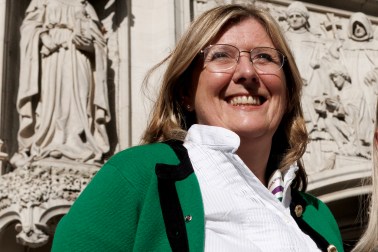This novella tells the story of the Crucifixion from the point of view of Mary. Contrary to art historical belief she was not, we are now told, kneeling at the foot of the Cross nor cradling her son’s broken body in her arms. Instead, she left the scene early, slipping away to save her own skin, stealing to meet her needs as she fled. It’s the sort of idea Carol Ann Duffy might make a poem about, except she’d do it with humour, and without Tóibín’s faintly sententious tone. ‘Memory fills my body as much as blood and bones’; there’s a lot of that kind of thing.
Mary is now an old woman, living out her days under surveillance, somewhere far from her native land. It’s probably Greece. It’s a landscape full of goats and olives and temples to Artemis, the ‘old goddess’ whom Mary feels a strong inclination to worship, because she ‘has seen more than I have and suffered more, because she has lived more’.
Mary is watched over by two men, insistent and unwelcome intruders on her solitude. They are not named, but they might be St John and St Paul. ‘There is something hungry and rough in them, a brutality boiling in their blood’; they feed and clothe Mary, but they persecute her too. What they want is her corroboration of their version of events. To them falls the task of creating a faith, of turning the life and death of Mary’s son (he is not named either) into the basis of a creed. Two other men lurk in the shadows, also bent on controlling history. They are ‘the strangler’ and ‘the man who played dice’, and Mary lives in terror of them. These two want her ‘silence’, while the pututive John and Paul ‘are looking for my voice, my witness’.
Mary knows that her version of events will not prevail. Her questioners can write; she cannot read what they have written. They are strong men, she is a frail old woman. She feels the lure of myth-making; in her own dreams and imaginings she finds herself reinventing, casting herself in a starring role: ‘I pulled the thorns out of his head and washed the blood out of his hair.’
One of the book’s strengths is the way it deals gently with the confusion of a mind clouded by age and sorrow. But the central fact emerges clearly: Mary did not believe that her son was the Son of God. To her, he was a political idealist who believed in a time to come ‘in which all would be different and all would be better. Such an idea swept through villages like a dry hot wind at that time, and it carried away anyone who was any use, and it carried away my son.’ She understands, and fears, the struggle for ownership of his legend. ‘Everything that happened will become a sweet story that will grow poisonous, as bright berries that hang low on trees.’
The book’s premise is striking, and Tóibín’s handling is subtle. Mary’s ambivalence towards the raising of Lazarus is particularly well done. The examination of the way history is fused from fact and fiction is interesting. But there is something lacking. Tóibín pares his prose down to the point where it seems drained of colour. His is a bold enterprise, sometimes too cautiously executed. I did not find myself believing strongly in any of the characters, and for a book about the nature of belief, that’s a significant problem. Or perhaps it’s part of the point.





Comments